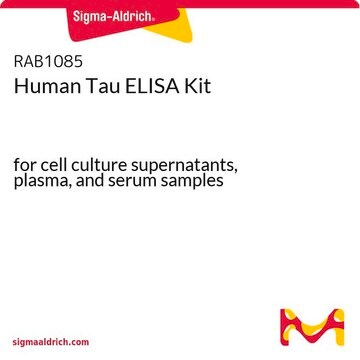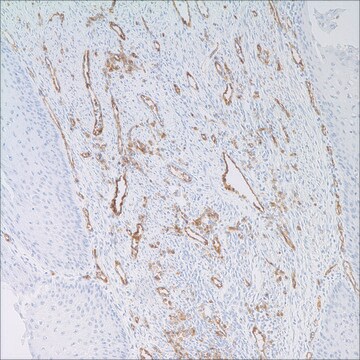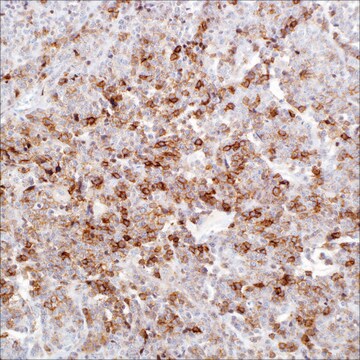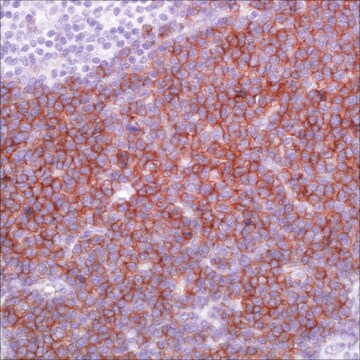GS05
GST S1-1, Recombinant Human
Sinonimo/i:
GSTS, GSTS1, PGD2, PGDS, hematopoietic prostaglandin D synthase
Autenticatiper visualizzare i prezzi riservati alla tua organizzazione & contrattuali
About This Item
Codice UNSPSC:
12352200
NACRES:
NA.26
Prodotti consigliati
Origine biologica
human
Livello qualitativo
Ricombinante
expressed in E. coli
Saggio
>95% (SDS-PAGE)
Stato
frozen liquid
Attività specifica
24.07
PM
23 kDa
Concentrazione
0.9 mg/mL
Temperatura di conservazione
−70°C
Informazioni sul gene
human ... HPGDS(27306)
Descrizione generale
using spectrophotometric determination of 1-fluoro-2,4-dinitrobenzene (FDNB) conjugation with reduced glutathione (1 mM) in 100 mM NaPO4 (pH 6.5) at room temperature.
Azioni biochim/fisiol
Glutathione S-transferase sigma 1, also know as hematopoietic prostaglandin D synthase (HPGDS) is an enzyme that in humans is encoded by the HPGDS gene. Glutathione S-transferases (GSTs) are a family of enzymes that play an important role in detoxification by catalyzing the conjugation of many hydrophobic and electrophilic compounds with reduced glutathione. Based on their biochemical, immunologic, and structural properties, cytosolic and membrane-bound forms of glutathione S-transferase are encoded by two distinct supergene families. At present, eight distinct classes of the soluble cytoplasmic mammalian glutathione S-transferases have been identified: alpha, kappa, mu, omega, pi, sigma, theta and zeta. The GSTs are thought to function in xenobiotic metabolism and play a role in susceptibility to cancer, and other diseases.
Prostaglandin-D synthase is a sigma class glutathione-S-transferase family member. The enzyme catalyzes the conversion of PGH2 to PGD2 and plays a role in the production of prostanoids in the immune system and mast cells. The presence of this enzyme can be used to identify the differentiation stage of human megakaryocytes.
Stoccaggio e stabilità
The enzyme should be used by the end-user customer within 1 year of receipt.
Codice della classe di stoccaggio
10 - Combustible liquids
Classe di pericolosità dell'acqua (WGK)
WGK 1
Punto d’infiammabilità (°F)
Not applicable
Punto d’infiammabilità (°C)
Not applicable
Scegli una delle versioni più recenti:
Certificati d'analisi (COA)
Lot/Batch Number
Non trovi la versione di tuo interesse?
Se hai bisogno di una versione specifica, puoi cercare il certificato tramite il numero di lotto.
Possiedi già questo prodotto?
I documenti relativi ai prodotti acquistati recentemente sono disponibili nell’Archivio dei documenti.
Marcus Kjellander et al.
Analytical biochemistry, 446, 59-63 (2013-10-26)
The previously uncharacterized Drosophila melanogaster Epsilon-class glutathione transferases E6 and E7 were immobilized on nanoporous alumina. The nanoporous anodized alumina membranes were derivatized with 3-aminopropyl-triethoxysilane, and the amino groups were activated with carbonyldiimidazole to allow coupling of the enzymes via
Morten Hohwy et al.
Journal of medicinal chemistry, 51(7), 2178-2186 (2008-03-18)
We describe the discovery of novel inhibitors of prostaglandin D2 synthase (PGDS) through fragment-based lead generation and structure-based drug design. A library of 2500 low-molecular-weight compounds was screened using 2D nuclear magnetic resonance (NMR), leading to the identification of 24
Brigette L Tippin et al.
Prostaglandins & other lipid mediators, 97(1-2), 22-28 (2011-08-09)
Intestinal tumors in Apc(Min/+) mice are suppressed by over-production of HPGDS, which is a glutathione transferase that forms prostaglandin D(2) (PGD(2)). We characterized naturally occurring HPGDS isoenzymes, to see if HPGDS variation is associated with human colorectal cancer risk. We
Tsuyoshi Inoue et al.
Journal of biochemistry, 135(3), 279-283 (2004-04-29)
Hematopoietic prostaglandin (PG) D synthase (H-PGDS) is responsible for the production of PGD(2) as an allergy or inflammation mediator in mast and Th2 cells. We determined the X-ray structure of human H-PGDS complexed with an inhibitor, 2-(2'-benzothiazolyl)-5-styryl-3-(4'-phthalhydrazidyl) tetrazolium chloride (BSPT)
Il team dei nostri ricercatori vanta grande esperienza in tutte le aree della ricerca quali Life Science, scienza dei materiali, sintesi chimica, cromatografia, discipline analitiche, ecc..
Contatta l'Assistenza Tecnica.








